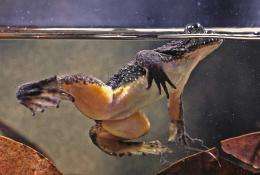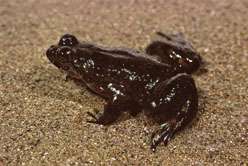Sound sensors help scientists prove unique frog not extinct

(Phys.org)—QUT researchers could soon have sound reason to believe Queensland's unique gastric brooding frog still exists in the Sunshine Coast hinterland.
Using world-first, QUT-developed environmental acoustic sensor technology, a QUT team of researchers is harnessing the help of the conservation community around Maleny to place the continuous recording devices near creeks in ten locations on private land in the hopes of recording the frogs' call.
Last seen in the wild in 1981 in the Conondale Ranges, the unassuming, small, brown frog has a strange way of parenting, says QUT ecologist Ian Williamson from QUT's School of Earth, Environmental and Biological Sciences.
"The female gastric brooding frog swallows the fertilised eggs which secrete a substance that turns off her gastric juices. The eggs then gestate in her stomach and are born as fully formed froglets," Dr Williamson said.
"This frog was first discovered in 1973 but the last sighting of it in the wild was in 1981; we are hoping that the frogs, if they are there, will start calling in spring during the mating season."
With the help of Queensland Parks and Wildlife staff, the team has already placed some acoustic sensors around the two creeks in the Conondale Ranges where the frogs were last spotted and is currently analysing nearly 4000 hours of sounds captured on the recordings.

The call of the gastric brooding frog sounds like "a washboard in a bush band", says QUT's Dr Michael Towsey, who has built software that can scan and identify the call of the gastric brooding frog.
"South-east Queensland has 71 species of frogs and of those, seven have a similar call to that of the gastric brooding frog. We can identify the gastric brooding frogs' call, however, because its dominant frequency is two octaves above middle C." Dr Towsey said.
"The software can automatically home in on the frog's particular frequency when scanning the thousands of hours of sound data we will collect and then point us to the time of day and place where the call was heard.
"Human researchers can then follow that call from the wild and go and look for the frogs." The
QUT PhD researcher Jason Wimmer, who is using the acoustic sensing system to study the diversity and numbers of native birds around Queensland, said the technology allowed round-the-clock recording, something that could never be done by human researchers in difficult terrain.
"We have done a couple of surveys round the Conondales with Queensland National Parks Rangers from Maleny looking for the frog. Moving through the rivers at night is difficult, and the noise of the creek makes it hard to hear any frog calls," Mr Wimmer said.
"The software we have developed can filter out the sound of the water - running water is below the frequency of the frog call. Our system can record and monitor in real-time 24/7 - something that would cost too much in time and money for human researchers.
"The accuracy of the scanning software also means that there will be no observer bias or subjective identification of the calls."
Provided by Queensland University of Technology



















